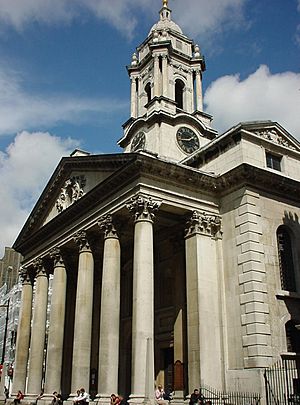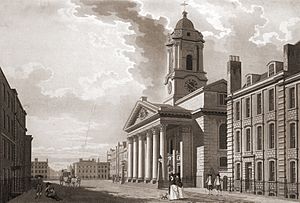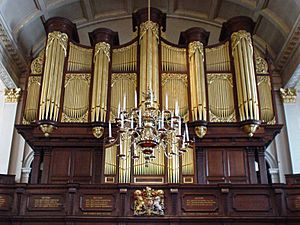St George's, Hanover Square facts for kids
Quick facts for kids St George's |
|
|---|---|

View from St George Street
|
|
| 51°30′45″N 0°8′34″W / 51.51250°N 0.14278°W | |
| Location | St George Street, Mayfair, City of Westminster, London |
| Country | United Kingdom |
| Denomination | Church of England |
| History | |
| Founded | 1725 |
| Architecture | |
| Heritage designation | Grade I |
| Architect(s) | John James |
| Years built | 1721–1725 |
| Administration | |
| Parish | St. George, Hanover Square with St. Mark |
| Diocese | London |
St George's, Hanover Square, is a famous church in London. It's part of the Church of England. This beautiful church is located in Mayfair, a well-known area in the City of Westminster. It was built a long time ago, in the early 1700s. The church was part of a big plan to build 50 new churches across London. A talented architect named John James designed it. General William Steuart gave the land for the church and helped start its construction in 1721. St George's is very close to Hanover Square and Oxford Circus. Because it's in such a popular spot, many important and famous weddings have taken place here.
Contents
The Church's Parish History
A "parish" is like a local area served by a church. In 1724, the area around St George's became its own parish. This new parish was created from a larger, older one called St Martin in the Fields.
Over the years, the boundaries of St George's parish changed a few times. This happened in 1830, 1835, and 1865. These changes were made as new parishes were formed from parts of St George's. The church's parish still exists today. It is part of the Deanery of Westminster St Margaret, which is in the Diocese of London.
Church Design and Building
The land for St George's Church was given by General Sir William Stewart. He was also known as Steuart. The church was built between 1721 and 1725. The money for its construction came from a special group called the Commission for Building Fifty New Churches.
The church was designed by John James. He was one of the main surveyors for the commission since 1716. The front of the church has a large entrance called a portico. It has six tall Corinthian columns that stick out over the sidewalk. Just behind this portico, a tower rises from the roof.
Inside the church, the main area is called the nave. It is separated from the side areas, called aisles, by strong pillars. These pillars are square up to the height of the galleries. Then, they become round Corinthian columns that reach the ceiling. The nave has a rounded, tunnel-like ceiling, known as a barrel vault. The aisles also have smaller, rounded ceilings.
Burial Grounds
When St George's Church first opened, it didn't have its own churchyard for burials. So, its first burial ground was located next to its workhouse on Mount Street. When this area became full, a larger burial ground was opened in Bayswater in 1765.
Both of these burial grounds were closed in 1854. This was done to protect public health in London. Many people were buried at St George's. These included Ann Radcliffe, a famous writer of "Gothic Novels." Also, the Revd. Laurence Sterne, an author and abolitionist, was buried here. Another notable person was Francis Nicholson, a British military officer.
The Mount Street burial ground was later cleared. The old tombstones were removed, and it was turned into a small park. Some of the old stones were even used for drainage. In 1969, the Bayswater burial ground was also cleared. This was to allow the land to be used for new buildings. Many remains were moved to West Norwood Cemetery and cremated.
Music at St George's
St George's Church has a professional choir. It is known for its strong tradition of choral music.
The famous composer Handel lived nearby. He lived at 25 Brook Street from 1723 until he passed away in 1759. Handel regularly attended services at St George's. He even helped choose the church's first organist, Thomas Roseingrave, in 1725. During his time living on Brook Street, Handel became a British citizen. He also wrote his famous work, Messiah, in 1741. Today, St George's is one of the places where the annual London Handel Festival is held.
In 2006, a special appeal was launched to raise money for the church. This "Restoration Fund Appeal" aimed to collect five million pounds. The first goal was to raise one and a half million pounds for important repair work. The church also hosts classical music concerts. These concerts help support the Restoration Fund. They often feature talented young musicians.
The church is also one of the main homes for the Orpheus Sinfonia. This is an orchestra made up of musicians who have recently finished music college.
Rectors of the Church
A rector is the main priest in charge of a parish church. Here are some of the people who have served as rector of St George's, Hanover Square:
- 1725–1759 Andrew Trebeck
- 1759–1774 Charles Moss
- 1774–1803 Henry Reginald Courtenay
- 1803–1844 Robert Hodgson
- 1845–1876 Henry Howarth
- 1876–1890 Edward Capel Cure
- 1891–1911 David Anderson
- 1911–1933 Norman Thicknesse
- 1933–1940 Henry Montgomery Campbell
- 1940–1955 Stephen Phillimore
- 1955–2000 William Maynard Atkins
- 2001–2004 John Slater
- 2005– Roderick Leece
Famous Weddings
From its very beginning, St George's Church became a popular place for weddings, especially for important families. Many notable people have been married here, including:
- Francis Dashwood, 11th Baron le Despencer, a politician, married Sarah Gould in 1745.
- Henry Holland, a famous architect, married Bridget Brown in 1773.
- John Nash, another well-known architect, married Mary Ann Bradley in 1798.
- Edward Rudge, a botanist, married the artist Anne Rudge in 1791.
- Theodore Roosevelt, who later became the President of the United States, married Edith Carow here in 1886.
- Opera singers Charles Manners and Fanny Moody were married in 1890.
- John Galsworthy, a writer who won the Nobel Prize in Literature, married Ada Nemesis Cooper in 1905.
- Henry Hall, a famous band leader, married Margery Harker in 1924.
Over time, the number of very high-society weddings at St George's changed. This was a part of broader social changes in the late 20th century.




